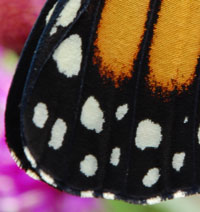|
April 2 Carolyn Summers workshop
 HGCNY and Baltimore Woods Nature Center are pleased to co-sponsor our first workshop. We're pleased to have Carolyn Summers, author of Designing Gardens with Flora of the American East as our presenter. HGCNY and Baltimore Woods Nature Center are pleased to co-sponsor our first workshop. We're pleased to have Carolyn Summers, author of Designing Gardens with Flora of the American East as our presenter.
Since the book's publication, she's been in great demand for presentations and has been given excellent reviews. We're delighted that she's coming to central New York.
REGISTRATION is now open
Call Baltimore Woods at 673.1350.
More information is on the Baltimore Woods website.
Note: There are two separate sessions, and you can register for one or both.
Good news! Official dues-paying Wild Ones members receive a discount.
Hurry! Registration is limited to 70 people, so register soon! |
 Update on monarchs At this time of year, their fat stores are running low, so monarchs
overwintering in Mexico will soon be starting their journey north.
Good news and bad news: The population has rebounded some from last year. BUT the population is still smaller than in the past. (See graph and current news...)
Migration video: There's a very nice 6-minute YouTube video on the monarch's life story from Amazing Journeys.
Temperature and survival: Did you know that monarchs need cold weather to survive? Journey North has an excellent slide show about how the balance between warm and cold affects the monarch's survival.
The Mexican people: The monarch's survival is tied to the life of the Mexican people. Journey North has a number of short, interesting videos of the life of the people near the monarch's overwintering areas. |
|
"Bee" ready to help pollinators
 | Lemon Queen sunflower (Helianthus annuus
'Lemon Queen') |
The plight of honey bees gets a lot of media attention, but scientists are increasingly discovering that native pollinators such as bumblebees are in decline, too. (Honey bees are not native to our continent.)
Scientists are also discovering how important native bees are for pollinating our crops and flowering plants in most ecosystems.
The good news is that home gardens can become a refuge for these important pollinators. Here's how:
1) Plant native plants throughout the season. Some especially good ones are bergamot (Monarda fistulosa), lavendar hyssop (Agastache foeniculum), coneflower (Echinacea purpurea), goldenrod (Solidago, such as S. caesia), New England aster (Aster novae-angliae), and sunflower (see below). Bees love many native shrubs, such as winterberry (Ilex verticillata), even though the flowers are small.
2) Provide nesting places. Bare ground is good for bumblebees, they may also nest under grasses such as the beautiful prairie dropseed (Sporobolus heterolepis). Solitary bees will appreciate various homes. See what they use in our yard and some of the commercial houses you can buy or make yourself (links to instructions are in the sidebar).
3) Don't use insecticides.
4) Participate in the Great Sunflower Project, a citizen science project. Plan to grow Lemon Queen sunflowers or one of the other kinds of flowers they list and count the number of bees that visit your plants. This will help scientists get an estimate of just how many bees there are...or are not.
|